













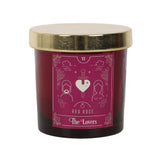
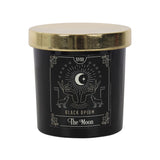
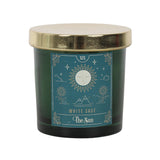
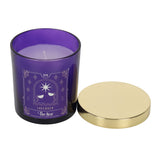
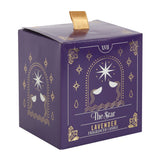
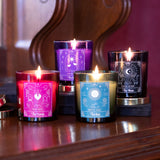
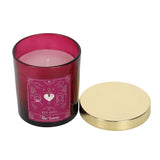
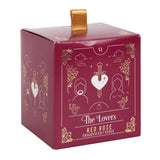
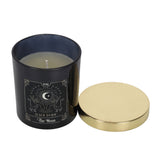
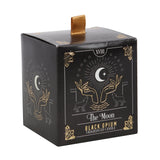
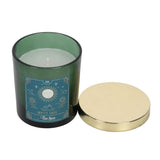
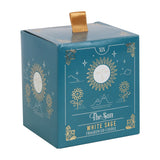
Mystic Tarot Candles
Illuminate your space and enhance your spiritual practice with our Tarot Candle collection. Each candle features a unique tarot design representing a different card, paired with a carefully selected fragrance to create an enchanting ambiance.
"The Star" is paired with a calming lavender scent to promote inner peace and relaxation. This candle features a beautiful tarot design of "The Star" card, with a lovely purple glass jar and a metallic gold lid.
"The Sun" is combined with the refreshing aroma of white sage to bring clarity and positivity. This candle features a tarot design of "The Sun" card, with a stunning orange glass jar and a metallic gold lid.
"The Lovers" is complemented with the romantic scent of red rose, perfect for enhancing the energy of love and relationships. This candle features a tarot design of "The Lovers" card, with a gorgeous red glass jar and a metallic gold lid.
"The Moon" is paired with the seductive fragrance of black opium to tap into your intuition and inner power. This candle features a tarot design of "The Moon" card, with a mysterious black glass jar and a metallic gold lid.
These beautifully presented candles are perfect for setting the mood during meditation, ritual, or tarot readings. With an average burn time of 25 hours, you can enjoy the magic for longer. Made from paraffin wax, each candle measures H8cm x W7.8cm x D7.8cm, and comes packaged in a box measuring H9cm x W8cm x D8cm.
Experience the magic of our Tarot Candle collection and choose the perfect variant to enhance your spiritual journey.
A tarot candle is a candle used in conjunction with a tarot card reading to enhance the reading's energy and intention. Here are some directions on how to use a tarot candle:
Ingredients You'll Need:
- A tarot candle (you can choose a color or scent that resonates with your intention or the reading).
- A tarot deck and a cloth or surface to lay out your tarot cards.
- A quiet, comfortable space where you can focus on your reading.
- Optional: any additional ritual tools, such as crystals, incense, or oils, that you like to use in your practice.
Steps:
-
Select the Appropriate Tarot Candle:
- Choose a tarot candle that aligns with the energy or intention of your tarot reading. Consider the color, scent, and any symbolism associated with the candle.
-
Prepare Your Space:
- Find a quiet and comfortable space where you won't be disturbed during your reading.
- Set up your tarot cards on a cloth or surface in front of you.
- If you have other ritual tools like crystals or incense, place them nearby.
-
Center and Ground Yourself:
- Before you begin, take a few moments to relax and clear your mind. You can do this through deep breathing, meditation, or any grounding technique that works for you.
-
Set Your Intention:
- Hold the tarot candle in your hands and set your intention for the reading. This could be a specific question, a desire for insight, or a general intention to receive guidance.
-
Anoint or Dress the Candle (Optional):
- You can enhance the candle's energy by anointing it with a corresponding oil or dressing it with herbs that align with your intention. Rub the oil or herbs onto the candle while focusing on your intention.
-
Light the Tarot Candle:
- Place the tarot candle near your tarot card spread.
- Light the candle while maintaining your focus on your intention. Visualize the candle's flame as a beacon of insight and guidance.
-
Perform Your Tarot Reading:
- Shuffle your tarot cards while concentrating on your question or intention.
- Lay out the cards in your preferred spread.
- As you read the cards, pay attention to any insights or intuitive feelings that arise. The candle's energy can enhance your connection to the cards and your intuition.
-
Meditate and Reflect:
- After completing the tarot reading, spend some time in meditation or quiet reflection. The candle's presence can help you receive deeper insights or messages.
-
Close the Ritual:
- When you are finished with your reading, thank the universe, any guides or deities you work with, and the energy of the candle for their assistance.
- Safely extinguish the tarot candle. You can do this with a snuffer or by gently blowing it out.
-
Record Your Insights:
- Write down the details of your tarot reading, including the cards drawn and any insights or messages you received.
Remember that using a tarot candle is a personal and symbolic practice. It can enhance your connection to the cards and your intuition, but the effectiveness may vary from person to person. Trust your intuition and your personal connection to the energy of the candle as you perform your tarot reading.
Tarot cards have a long and intriguing history, and there are many fun and fascinating facts associated with them. Here are some fun facts about tarot:
-
Ancient Origins: Tarot cards were originally created as playing cards in the 15th century in Italy. They were not initially used for divination or fortune-telling.
-
Deck Structure: A standard tarot deck consists of 78 cards, divided into two main categories: the Major Arcana (22 cards) and the Minor Arcana (56 cards).
-
Major Arcana: The Major Arcana cards are often considered the most significant in a tarot deck. They represent major life events, archetypal symbols, and spiritual lessons.
-
Minor Arcana: The Minor Arcana cards are divided into four suits: Wands, Cups, Swords, and Pentacles (or Coins). Each suit corresponds to different aspects of life, such as emotions, intellect, and material wealth.
-
Tarot and Playing Cards: The tarot deck is believed to have evolved from standard playing cards, and the suits in a tarot deck closely resemble those in modern playing cards.
-
Rider-Waite Tarot: One of the most popular and widely used tarot decks is the Rider-Waite Tarot, created by A.E. Waite and illustrated by Pamela Colman Smith in 1910. It is known for its detailed and symbolic artwork.
-
Tarot Symbolism: Tarot cards are rich in symbolism and can be interpreted in various ways. Each card has multiple layers of meaning, making them versatile tools for divination, introspection, and creative inspiration.
-
Fortune-Telling and Guidance: While tarot cards are often used for fortune-telling, they are also employed for self-reflection, personal growth, and gaining insights into one's life path.
-
Misconceptions: Tarot cards are sometimes misunderstood as tools for predicting the future with absolute certainty. In reality, tarot readings are more about providing guidance, insights, and potential outcomes based on the present moment.
-
Pop Culture: Tarot cards have made appearances in various forms of popular culture, including movies, television shows, and literature. They are often depicted as mysterious and magical tools.
-
Tarot Spreads: There are numerous tarot spreads, each designed for specific types of questions or situations. Some spreads are simple, while others are complex and require more cards.
-
Tarot Readers and Psychics: Many people consult tarot readers or psychics for guidance and insight. Professional tarot readers use their intuition and knowledge of card symbolism to provide interpretations.
-
Historical Figures and Tarot: Some historical figures, such as Carl Jung and Aleister Crowley, had a deep interest in tarot and its symbolic meanings. Jung even incorporated tarot into his psychological theories.
-
Tarot Artistry: Tarot decks come in a wide range of artistic styles. Some are traditional, while others feature contemporary or unconventional artwork. Collecting tarot decks has become a popular hobby for many enthusiasts.
-
Global Tarot Variations: Tarot decks exist in various cultural variations beyond the traditional Rider-Waite deck. For example, the Tarot de Marseille is a well-known French tarot deck with its own unique symbolism.
-
Tarot and Numerology: Numerology plays a significant role in tarot. Each card is associated with a specific number, and these numbers hold additional meaning and significance in readings.
-
Online Tarot Readings: In the digital age, there are many online tarot reading websites and apps that offer virtual tarot card readings.
-
Tarot Conventions: Tarot enthusiasts and professionals often attend tarot conventions and conferences to share knowledge, learn from each other, and explore new decks and interpretations.
Whether you view tarot as a tool for guidance, a form of entertainment, or a spiritual practice, its rich history and symbolism make it a captivating and enduring aspect of mystical and esoteric traditions.
